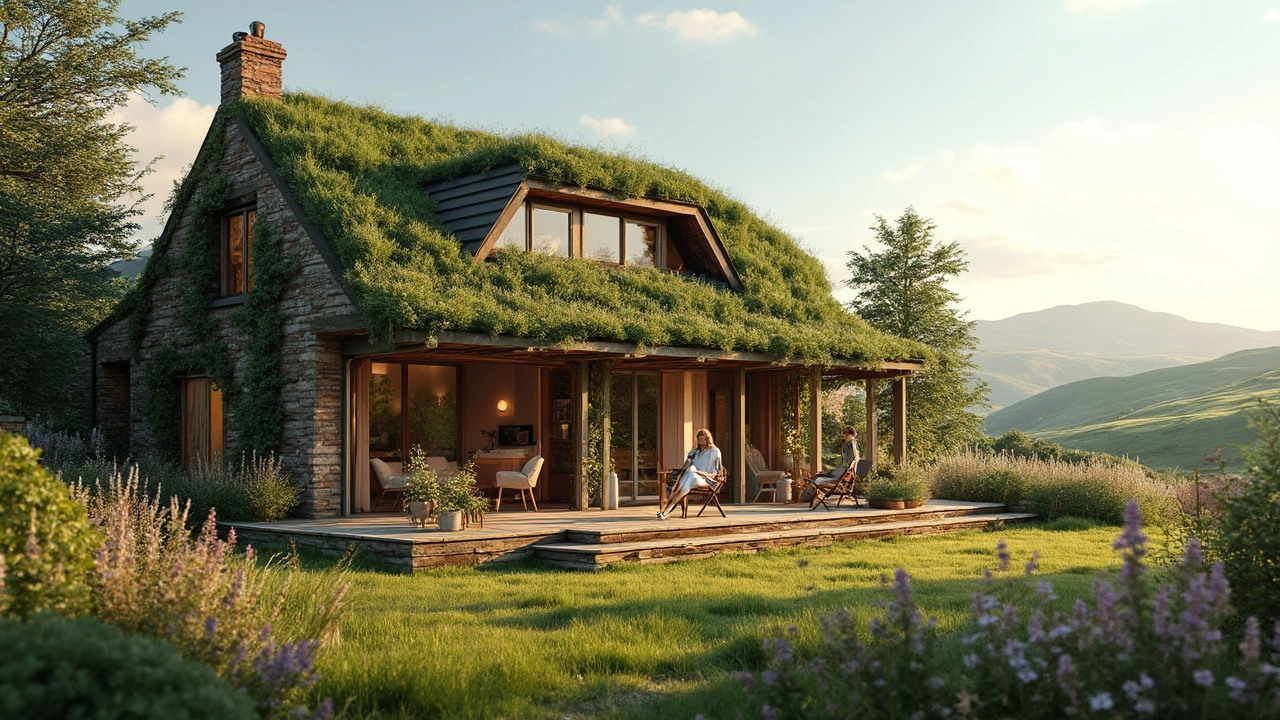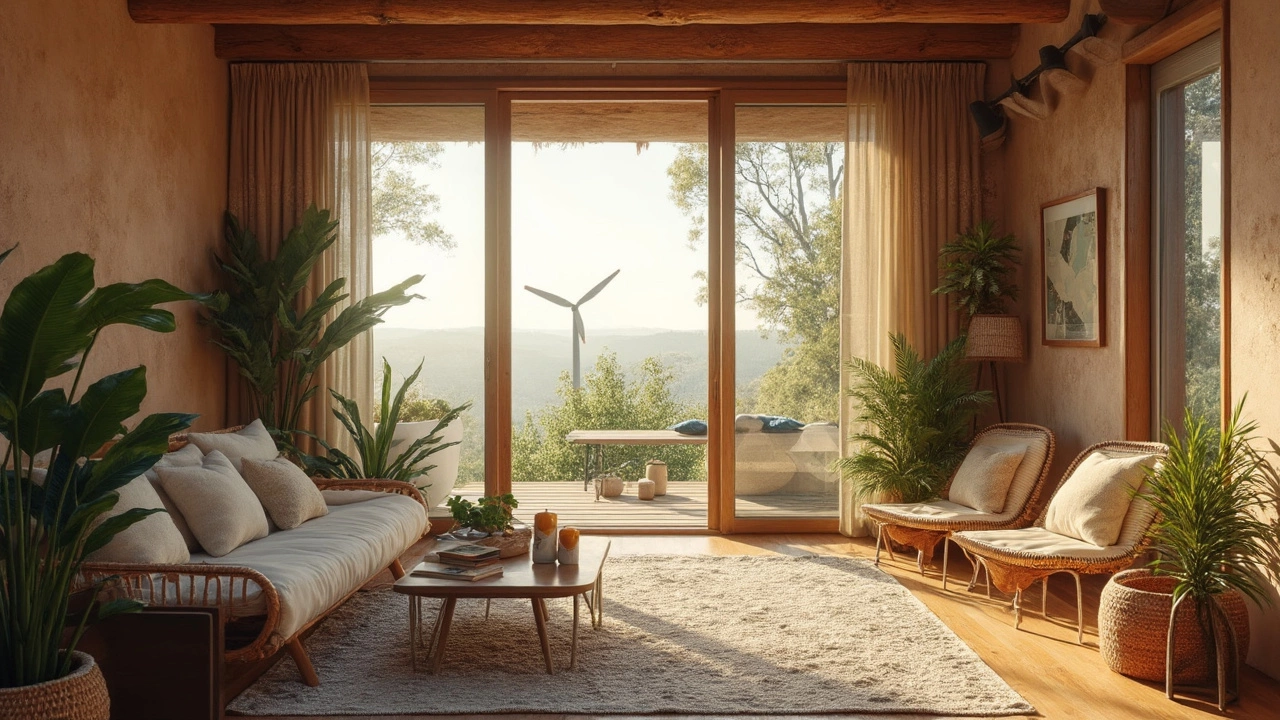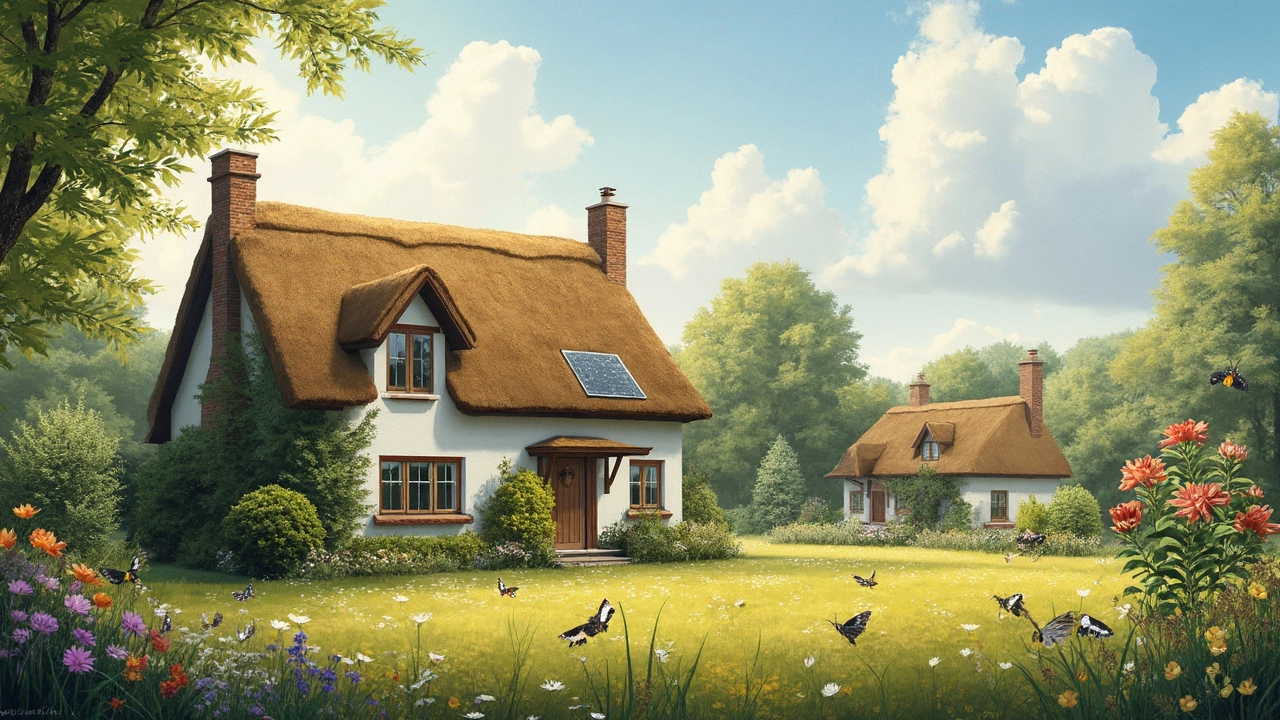Eco-Friendly Cottages: Finding the Greenest Home
15 Mar, 2025If you’ve ever dreamed about living in a home that’s as kind to the planet as it is to you, an eco-friendly cottage might just be your ideal match. These homes are gaining attention for their sustainable designs and minimal environmental impact. But what exactly makes a cottage eco-friendly?
First off, it’s all about energy efficiency. Imagine a house that uses minimal energy and saves on utility bills—sounds good, right? From solar panels to high-performance insulation, every detail matters. It’s not just about the tech; it’s about creating a space that complements nature rather than competes with it.
Another key aspect is the materials. When we say eco-friendly, think bamboo floors instead of hardwood or recycled steel instead of fresh-cut timber. These choices not only reduce waste but also promote sustainability. And let’s be real, who doesn't love a house with a story behind every element?
- Understanding Eco-Friendly Homes
- Importance of Energy Efficiency
- The Role of Sustainable Materials
- Innovative Building Techniques
- Tips for Choosing an Eco-Friendly Cottage
Understanding Eco-Friendly Homes
Ever looked at homes and wondered how some manage to be both cozy and planet-friendly? Well, that's the magic of eco-friendly cottages. These homes are designed not just to make life comfortable but also to ensure the earth pays as little as possible for it.
They typically start with energy efficiency. A house that keeps the heat in during winter and out in the summer without cranking up your heater or A/C is a win for your wallet and the planet. This often involves using materials like double-glazed windows and top-notch insulation.
Key Elements of Eco-Friendly Homes
- Renewable Energy Sources: Solar panels aren't just for tech lovers. They’re a staple in eco-friendly living, harnessing the sun's power to keep everything running smoothly.
- Sustainable Materials: Think recycled metal, reclaimed wood, or sustainably harvested bamboo. Not only do they look good, but they also tread lightly on the earth.
- Efficient Water Usage: Rainwater collection systems and low-flow fixtures make sure we use water wisely.
Why It Matters
By choosing a green home, you’re doing more than just saving bucks. You’re cutting down on carbon emissions, aiming for a healthier indoor atmosphere, and making a statement that sustainability is a priority.
Did you know? According to a 2023 survey in Canada, homes with energy-efficient features can reduce utility costs by up to 30%. That’s good for the planet and your bank account!
Importance of Energy Efficiency
When it comes to crafting the perfect eco-friendly home, energy efficiency is a big deal. Why? Well, energy-efficient cottages not only slash those electricity bills but also shrink your carbon footprint. That's a win-win for you and the planet.
Smart Heating and Cooling
Let’s talk about heating and cooling systems. These are often the biggest energy guzzlers in any home, so making them efficient is crucial. High-efficiency heat pumps, for instance, can offer both heating and cooling, consuming much less energy than traditional systems.
"Switching to high-efficiency heating systems can reduce energy use by 50% compared to traditional units," says the Energy Star Program.
Lighting the Way
Lighting is another area where you can save lots of energy. LED bulbs, while more expensive upfront, last longer and use significantly less electricity than old-school incandescent bulbs. They might not sound thrilling, but when you're saving energy and cash, they're like your best pals.
Windows and Insulation
Don’t underestimate the power of good insulation and windows. Dual or triple-pane windows with gas fills and low-emissivity (low-e) coatings are game-changers. They keep heat in during winter and out during summer, meaning your heating and cooling systems don't have to work overtime.
Take a look at this average energy-saving stat:
| Feature | Energy Savings |
|---|---|
| High-efficiency Windows | 25-50% |
| LED Lighting | 75-80% |
| Smart Thermostats | 10-23% |
Embracing Renewable Energy
Incorporating renewable energy like solar panels can dramatically boost your home’s efficiency. While the initial setup might seem steep, they pay off in the long run by drastically reducing dependence on fossil fuels. Not to mention, they often come with tax incentives.
So, when hunting for an eco-friendly cottage, or when thinking of upgrades, make energy efficiency your top priority. It’s about being savvy today for a brighter, cleaner tomorrow.

The Role of Sustainable Materials
When building or choosing an eco-friendly cottage, sustainable materials play a huge role. It’s not just about recycling and reducing waste; it’s about choosing resources that have a minimal impact on the planet while still delivering durability and style.
The Power of Renewable Resources
One of the big stars in sustainable building is bamboo. Why? It grows insanely fast and can be harvested without killing the plant. Imagine replacing a hardwood floor that's been years in the making with a vibrant bamboo alternative that regenerates quickly. Pretty neat, right?
Recycled materials are also making waves. Take steel, for instance. Using recycled steel for roofing and structuring isn’t just efficient; it keeps tons of waste out of landfills. And let’s not forget about reclaimed wood. Found in old barns and factories, it brings a rustic charm you just can't buy off the shelf.
Insulation and Finishes Done Right
Insulation is another area where you can make eco-friendly choices. Options like sheep's wool or cellulose, which often comes from recycled paper, ensure your home stays cozy without the carbon-heavy footprint of traditional materials.
And for finishes? Low-VOC paint is the way to go. It reduces air pollution inside your home, which is a win for both the environment and your lungs.
Materials by the Numbers
Consider these figures: Using recycled materials can save between 40% to 60% of the energy compared to making new materials. That's a massive reduction in emissions and resource consumption.
Remember, every time you choose these sustainable materials, you're casting a vote for a cleaner, greener world. It's not just about building a house; it's about building a future.
Innovative Building Techniques
When it comes to building an eco-friendly cottage, thinking outside the box can make all the difference. Modern homes are now being constructed with techniques that prioritize sustainability without sacrificing comfort or aesthetics. So, what’s new in the world of green building?
Passive Solar Design
One of the standout techniques is passive solar design. This isn't just about slapping on a couple of solar panels and calling it a day. Instead, it’s about aligning the structure to capture natural sunlight during cooler months while providing shade in the summer. This approach maximizes natural energy and can significantly cut down on heating and cooling costs.
Green Roofs and Walls
Ever thought of having a garden on your roof or walls? Green roofs are not only visually stunning, but they also help in insulating the home, reducing the need for artificial heating and cooling. Plus, they’re great for biodiversity, offering a habitat for birds and insects.
Modular Construction
Another game-changer is modular construction, where parts of the home are built off-site and then assembled on-location. This minimizes waste and speeds up the building process. Modular homes are known for their precision and efficiency, often featuring sustainable materials that are durable yet gentle on the environment.
Smart Home Technology
Don't forget about smart home tech. From programmable thermostats that adjust to your schedule to systems that track energy usage, these innovations make it easier than ever to live sustainably.
Structural Insulated Panels (SIPs)
We also can't overlook structural insulated panels, or SIPs, which are a total upgrade from traditional framing. They offer superior insulation, reducing the need for extra heating. Thanks to their tight construction, they also help in lowering energy bills by up to 50% compared to traditional homes.
Choosing the right building technique can turn a regular house into an eco-friendly sanctuary, and it’s great to see such creativity in the field.

Tips for Choosing an Eco-Friendly Cottage
Ready to dive into the world of eco-friendly cottages? Picking the right one involves more than just gut feeling; it’s about conscious choices. Let's break down some practical steps to ensure your cottage fits the green bill.
1. Look for Energy Efficiency
This one's big. An energy-efficient home means lower bills and a smaller carbon footprint. Go for features like solar panels, LED lighting, and efficient HVAC systems. A cottage with proper insulation retains heat in winter and keeps cool in summer, saving you energy all year round.
2. Check Out the Building Materials
Materials make the house, literally. Opt for renewable resources such as bamboo or recycled materials. Look for certifications like the FSC (Forest Stewardship Council) label on wood products, ensuring they are sustainably sourced.
3. Water Conservation
Water is precious, so a smart eco-friendly cottage should have water-saving fixtures. Low-flow toilets and showerheads, and if you're planning on some landscaping, think of drought-resistant native plants.
4. Location and Orientation
The placement of the cottage can affect its eco-credentials too. Ideally, a southeast orientation takes full advantage of sunlight, maximizing natural light and reducing the need for artificial lighting. Plus, it feels good to wake up to the sunrise.
5. Size Matters
Bigger isn’t always better. A compact yet cozy home minimizes the use of materials and energy. Think of clever space-saving solutions like multi-purpose furniture to maximize what space you do have.
6. Community and Infrastructure
Consider the community and surrounding infrastructure. Proximity to public transport means less reliance on cars, and nearby amenities reduce the need to travel far for necessities. A place that's walkable scores bonus eco points.
Bonus Tip: Green Certifications
When in doubt, check for certifications like LEED (Leadership in Energy and Environmental Design). These labels help ensure that a home meets rigorous environmental standards, giving you peace of mind.
Choosing an eco-friendly cottage isn't just a trend—it's a lifestyle choice with long-reaching benefits for you and the planet. Have fun on your green journey!

 by
by